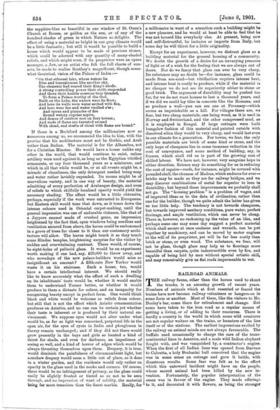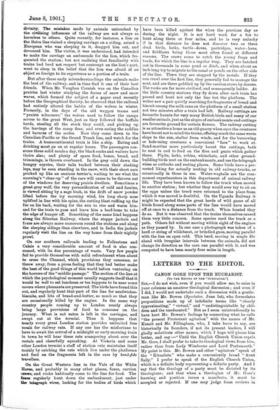RAILROAD ANIMALS.
THE railway fauna, other than the horses used to shunt the trucks, is an amusing growth of recent years. Numbers of animals which at first resented or feared the trains have now become railway volunteers or hangers-on in some form or another. Most of them, like the visitors to Mr. Dooley's bar, come there for refreshment and change. But some have taken to the iron road as a regular means of getting a living, or of adding to their resources. There is hardly a country in the world in which some wild creatures are not regular waiters on the trains, or haunters of the line itself or of the stations. The earliest impressions excited by the railway on animal minds are not always favourable. The buffalo used occasionally to charge the ears of the trans- continental lines in America, and a male wild Indian elephant fought with, and was vanquished by, a contractor's engine. When the first of all Indian lines was opened from Burwan to Calcutta, a holy Bra.hmini bull conceived that the engine was in some sense an outrage and gave it battle, with disastrous results. Some fear was felt as to the effect which this untoward incident might have on the people, whose sacred animal had been killed by the new in- vention. Fortunately, the popular interpretation of the omen was in favour of the engine. They made offerings to it, and decorated it with flowers, as being the stronger
divinity. The mistakes made by animals untouched by the civilising influences of the railway are not always so harmless to others. Quite recently, for instance, a lion on the Beira line visited a sleeping carriage on a siding, seized a European who was sleeping in it, dragged him out, and devoured him. The victim, it was understood, had intended to make the carriage an ambuscade for the lion, which fre- quented the station; but not realising that familiarity with trains had bred not respect but contempt on the lion's part, went to sleep in the belief that the lion was afraid of an object so foreign to its experience as a portion of a train.
But after these early misunderstandings the animals make the best of the railway, and in time find it one of their best friends. When Mr. Vaughan Cornish was on the Canadian prairies last winter studying the forms of snow and snow waves, which formed the subject of a paper read recently before the Geographical Society, he observed that the railroad had entirely altered the habits of the wolves in winter. Formerly, in the days of the old waggon teams and "prairie schooners," the wolves used to follow the camps across to the great West, just as they followed the buffalo herds, stealing all the stock they could, and picking up the leavings of the camp fires, and even eating the saddles and harness of the mules. Now they come down to the Canadian-Pacific or the Grand Trunk line, and watch for the trains. A transcontinental train is like a ship. Eating and drinking must go on at regular hours. The passengers con- sume three solid meals a day, the black cooks and waiters have theirs also; and plenty of spare food, bones, bread, and trimmings, is thrown overboard. In the grey cold dawn the hungry coyotes, their tails tucked between their shaking legs, may be seen standing in the snow, with their short ears pricked up like an anxious terrier's, waiting to see what the morning's " clear-up " of the cars will cause to be thrown out of the windows for deserving prairie dwellers. Sometimes a great grey wolf, the very personification of cold and famine, is viewed sitting by a sage bush, in the drift of snow powder lifted before the icy morning wind, his long sharp nose uplifted in line with his spine, the cutting blast ruffling up the fur on his back, waiting for the sun to rise and warm him, and for the train to pass and leave him a beef-bone to take the edge of hunger off. Something of the same kind happens along the Siberian Railway, where the steppe jackals and foxes are always more numerous round the stations and along the sleeping sidings than elsewhere, and in India the jackals regularly visit the line on the way home from their nightly prowL On our southern railroads leading to Folkestone and Calais a very considerable amount of food is also con- sumed, with its due percentage of waste. Very few people fail to provide themselves with solid refreshment when about to cross the Channel, which provisions they consume, or throw away, from a pima; feeling that they had better make the best of the good things of this world before venturing on the horrors of the "middle passage." The section of the line at which the psychological moment usually suggests itself that it would be well to eat luncheon or tea happens to be near some covers where pheasants are preserved. The birds have found this out, and regularly hunt that part of the line for sandwiches, biscuits, and bits of bread-and-butter, so much so that they are occasionally killed by the engine. In the same way country people coming up to London nearly always bring large provisions of food to consume on the journey. What is not eaten is left in the carriages, and swept out at the termini. Thus it happens that nearly every great London station provides unlimited free meals for railway rate. If any one has the misfortune to have to await the arrival of a midnight or early morning train in town he will hear these rats scampering about over the metals and cheerfully squeaking. At Victoria and some other London termini a staff of station eats maintains itself mainly by catching the rats which live under the platforms and feed on the fragments left in the cars by bond-fide travellers.
On the Great Western line in the Vale of the White Horse, and probably in many other places, foxes, carrion avows, and rooks habitually come to the line for food. The bawl regularly hunt down the embankment, just under the telegraph wires, looking for the bodies of birds which
have been killed against the wires the previous day or during the night. It is not hard work for a fox to hunt along three or four miles, and he is very unlucky if in that distance he does not discover two or three dead birds, larks, turtle. doves, partridges, water - hens, and fieldfares being those most often found at different seasons. The crows come to catch the young frogs and toads, for which the line is a regular trap. They are hatched out in thousands in some pond or ditch, and when about an inch long try to migrate to the canal or ponds on the other side of the line. There they are stopped by the metals. If they can crawl over the first line, they generally fail to manage the next, and are there gobbled up by the carrion crows by dozens. The rooks are far more civilised, and consequently bolder. At the little country stations they fly down after each train has passed and hunt not only the line but the platform. The writer saw a pair quietly searching for fragments of bread and biscuit among the milk cans on the platform of a small station not two minutes after a train had left. Railway cuttings are favourite haunts for very many British birds and many of our smaller animals, just as the slopes of embankments and cuttings are favourite ground for certain flowers. The railway cutting is as attractive a home as an old quarry when once the creatures have learnt not to mind the trains, offering much the same warm slope to the sun, shelter from winds, and for the burrowing or hole-using creatures a convenient " face " to work at. Sand-martins more particularly haunt the cuttings, both to neat in and to feed on the flies and gnats which gather there. Pipits, larks, robins, whinchats, and other ground. building birds nest on the embankments, and use the telegraph wires as outlooks and resting places. Some birds have a per- verted liking for actually nesting in old railway-trucks, or occasionally in those in use. Water-wagtails are the com- monest experimenters in this department of animal railway life. They have been known to follow the truck when moved to another station ; but whether they would ever try to sit on the eggs unless the truck were returned to the place from which it was moved is doubtful. On the Uganda Railway it might be expected that the great herds of wild game of all kinds found along some parts of the line would have moved off at once to a distance from the track. When hunted they do so. But it was observed that the trains themselves caused them very little concern. Some species used the track as a path. Others fed without moving within sight of the engines as they passed by. In one case a photograph was taken of a herd or string of wildebeest, or brindled gnus, moving parallel with the line on open veld. This herd, moving in single file ahead with irregular intervals between the animals, did not change its direction as the cars ran parallel with it, and was computed to have been nearly four miles in length.







































 Previous page
Previous page